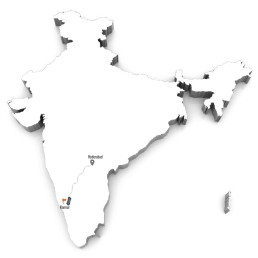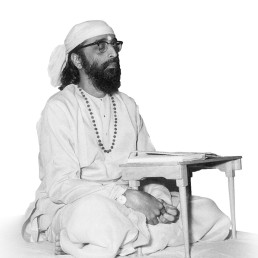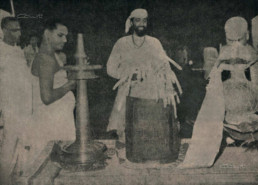
Jnana Yajna 55

Year & Dates:
April 05, 1959 to April 16, 1959

Yajna Topic:
Shrimad Bhagavad Gita- Chapter 12

Place:
Kannur (Cannanore), India.
A historic seaport along the Malabar coast of northern Kerala, Kannur (known earlier as Cannanore) is a picturesque town also famous for its weaving industry and pristine beaches. There, on the evening of April 5, 1959, at the Sundareshwara temple, Pujya Gurudev was given a traditional, Kerala-themed welcome by Shri Haridas Govardhandas, the president of the yajna committee. The 11-day, 55th Jnana Yajna was inaugurated by Sri V. M. Nair, Editor of Mathrubhumi, a widely read newspaper of Kerala. Pujya Gurudev chose to share the message of devotion, focusing on Shrimad Bhagavad Gita’s chapter 12, Bhakti Yoga, in that Jnana Yajna. In His introduction, He analyzed how despite the growing comforts in life, the problems that plague mankind cannot be “correctly diagnosed and treated” using only the narrow field of vision of politicians, economists, or scientists.
Gita Distilled and Delivered
Pujya Gurudev’s treatment through His Gita Jnana Yajnas was systematic so that the solutions could be long-acting. And, the 700 verses of Gita were the distilled essence apt for the many-faced Arjuna disease in the modern world. But first, the powerful remedy had to be brought from the decorated altar in puja rooms into the living spaces to heal and strengthen. Pujya Gurudev was facilitating that with keen estimation and consistent patience, choosing carefully the right chapter for each town or city.
For the quaint and small Kannur, in that brief Jnana Yajna, Pujya Gurudev chose Chapter 12, Bhakti Yoga. Over a thousand people gathered every evening in the yajnashala erected within the temple, careful not to miss Pujya Gurudev’s thought flow. Mindful that their questions were similar to what Arjuna asked, Pujya Gurudev explained the obstacles that arose when trying to attune the mind to an unmanifest Supreme Principle. Then what should be the way to worship a God with a form? Is a seeker who builds equipoise through detachment and meditates on the Infinite a better devotee? Clearly and thoroughly, the path of devotion and the promise of Bhagavan that a steadfast devotee undoubtedly reaches Him was laid out; When the earnest audience of Kannur heard Pujya Gurudev enumerate the thirty-six magnanimous qualities of a perfect devotee who is very dear to Bhagavan, they were deeply inspired.
Though only for eleven days, the 55th Jnana Yajna made an indelible mark on the psyche of Kannur, endowing the people with the faith that Gita is a divine panacea.
Photo Gallery

“Think,” Says Pujya Gurudev
Generally there is a feeling that the Path of devotion is a very easy and simple way for self-perfection. In fact no path is easy. It is equally true to say that no chosen path is difficult for the seeker who has chosen it. Paths are different only because of the vehicles employed: in a boat we can never travel on the grand trunk road, nor can we in a plane sail over the waves, nor on a cycle dash at 60 miles an hour! There are limitations for each vehicle. But in all of them progress is assured to the intelligent and the careful. Similarly, for self-development each type of seekers according to the vehicle available with them choose either the Path of Devotion or the Path of Action or the Path of Knowledge. To each one of them his Path is the easiest.
From Tyagi Magazine
That intelligent relationship maintained by seeker towards the world outside whereby experiences in himself a uniform steadiness in himself, in spite of the mad revelry of things and beings around him, is called the condition of equanimity. One who has developed the right sense of discrimination can easily watch for and see the golden chord of Beauty that holds together all that is enchanting and grotesque in the world outside. This capacity is called Samabuddhi.
From Tyagi Magazine
Which Spiritual Path is right for you?
Bhagavan Shri Krishna suggests alternative spiritual paths according to our inclination and aspiration. Whether through devotion, practice, action, or renunciation, discover the path that resonates with you on your journey to self-realization.


